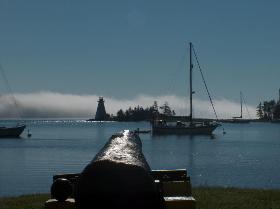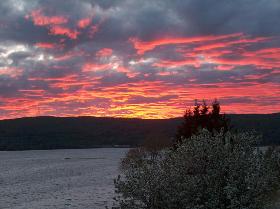All About Cape Breton – An Overview
In order to get a sense of the communities and the regions where our properties are located, please read the below overviews of BADDECK (many of our properties are within a 30-minute drive of Baddeck and it is where we live), CAPE BRETON more generally, and NOVA SCOTIA for those unfamiliar with the east coast of Canada.
BADDECK
Many of our properties are within a 30-minute drive of Baddeck, which is often described as being in the heart of the island because of its central location and its cozy community feel. Its is frequent stopping point for tourists and a family and retirement community for year-round residents.
For a community with a population of only 1,000 — it’s often said there’s one hotel, motel or B&B room for every permanent resident of the village — there’s more services and amenities than you might expect. And it’s on the doorstep of the spectacular Bras d’Or Lakes.
There’s a state-of-the-art hospital, a doctor’s clinic, a pharmacy, a police detachment, and paramedic base right in Baddeck. And there’s grocery, gift, and convenience stores open year-round.
For the golfer, there’s the 18-hole nationally-recognized Bell Bay Golf Club, and the 9-hole Baddeck Forks Golf Club, which has just recently undergone some significant renovations.
For the overall sports lover, there is an arena with regular hockey and public skating schedules; an active curling club with nightly activity during the winter; as well as badminton and basketball leagues, and various exercise classes. In the summer, swimming, yachting, kayaking, and boating of any kind are popular among visitors and local residents alike. The area is also a snowmobiler's dream, with the Cape Breton Highlands a particularly popular destination.
For the nature lovers and enthusiasts the stunning Cape Breton Highlands National Park is just a stone’s throw away, and there are eight protected provincial wilderness areas. Five of them — Middle River Wilderness Area, French River Wilderness Area, Margaree River Wilderness Area, North River Wilderness Area, Trout Brook Wilderness area — are within 30 minutes of Baddeck.
Four rivers, also within a half-hour of Baddeck — Middle River, North River, Baddeck River and Margaree River — are great for fishing, and there’s hiking opportunities galore at Uisge Ban Falls in Big Baddeck and at North River Falls, to name just two of many.
Baddeck also has plenty to offer for those interested in the arts with regular performances by local bands and singer-songwriters. Entertainment is a regular feature at the yacht club, legion, and other venues. Local artwork and crafts are prominently displayed and featured at several of the gift shops in the village.
There are accommodations to suit every taste and budget, and 30+ dining options in and around Baddeck during the peak tourism season (May to October). Year-round there’s a few locally-owned restaurants, cafes and pizza shops which stay open.
Baddeck is also just an hour’s drive to the Sydney Airport, which is serviced year-round by Air Canada, and seasonally by WestJet. There’s daily flights to Halifax and Toronto. And if you’re looking to fly directly from an international airport, the Halifax airport is a three-and-a-half drive away. There’s also bus, and car rental services from the village, and the ferry to Newfoundland is just 45 minutes away.
In addition to being a destination on its own — Baddeck is home to the Alexander Graham Bell National Historic Site and is a starting and stopping point for many people traveling the world-renowned Cabot Trail — the village is also close to all of the island’s other main attractions and destinations from Louisbourg to Ingonish, the Margaree Valley to Port Hawkesbury, the North Shore to Sydney. All are within a 90-minute drive.
CAPE BRETON
Located on the northeastern tip of Nova Scotia, Cape Breton Island is joined to the mainland by the Canso Causeway. It consists of four municipalities – the Cape Breton Regional Municipality (CBRM), the Municipality of Victoria County, the Municipality of Inverness County, and the Municipality of Richmond County – as well as the Town of Port Hawkesbury. The island is home to five First Nations communities – Membertou, Eskasoni, Wagmatcook, We’koqma’q, and Potlotek.
The population of the island is 132,010 and it is approximately 10,000 square kilometres in size.
Sydney is the island’s largest centre and is home to the Cape Breton Regional Hospital, major federal, provincial and municipal government offices and services, and shopping centres and other large retail outlets. Sydney is also home to Cape Breton University, the Marconi campus of the Nova Scotia Community College, and the Canadian Coast Guard College.
There are direct flights into Sydney from Toronto and Halifax, and vice-versa, with the Sydney Airport being serviced by both Air Canada and WestJet. In nearby North Sydney, the Marine Atlantic ferry terminal takes travelers to Newfoundland. The island also has bus, shuttle, and taxi services.
Fishing and tourism are major industries on the island. Cape Breton’s natural beauty and numerous attractions draw people from around the globe each year. The world-renowned Cabot Trail, the Cape Breton Highlands National Park, the Fortress of Louisbourg and Alexander Graham Bell National Historic sites, top-ranked golf courses like Cabot Cliffs and Cabot Links, and Bras d’Or Lake are just a few of the most popular draws and attractions. Bras d’Or Lake, a large inland sea, and the areas surrounding the lake are designated as a World Biosphere Reserve, a prestigious international designation from the United Nations Educational, Scientific, and Cultural Organization (UNESCO) for an area in the world which is deemed to demonstrate a "balanced relationship between humans and the biosphere."
Arts and culture are also prominent on the island, which is well known for its strong musical traditions, and its many talented musicians, dancers, and artisans. The Celtic Colours International Festival is a major annual event held each October in Cape Breton.
Cape Breton has a moderate climate and features four distinct seasons – winter, spring, summer and fall. The island is perhaps best known for its fall season, when the leaves change colour, producing spectacular scenery in October. Typical temperatures in Cape Breton are as follows:
Mid March to late April: 0-10 °C (32 to 50 °F)
Late April to mid June: 10 to 20 °C (50 to 70 °F)
Mid June to mid September: 20 to 25 °C (70 to 80 °F)
Mid September to mid November: 10 to 20 °C (50 to 70 °F)
Mid November to mid December: 0 to 10 °C (30 to 50 °F)
Mid December to mid March: 0 to -15 °C (0 to 32 °F)
NOVA SCOTIA
Located on the Atlantic coast of Canada, Nova Scotia boasts 7,400 kilometres of coastline, the highest tides in the world, and spectacular lakes and forests. The province is almost completely surrounded by the Atlantic Ocean and no point in Nova Scotia is more than 60 km from the sea.
The population of Nova Scotia is approximately 953,000 and English is the official language, although French, Mi’kmaq, Gaelic and a number of other languages are also spoken by residents.
The province’s capital city is Halifax, a major international seaport and transportation centre as well as the economic and cultural hub of the region. Halifax is also home to an international airport with daily flights to points around the globe.
The province is located within the Atlantic Standard Time Zone (AST) four hours behind Greenwich Mean Time (GMT), one hour ahead of Eastern Standard Time (EST) and halfway between the time zones of the United Kingdom and California. Nova Scotia is less than a two-hour flight from Boston and New York in the U.S., as well as Montreal and Toronto. It is also less than a six-hour flight to Europe.



